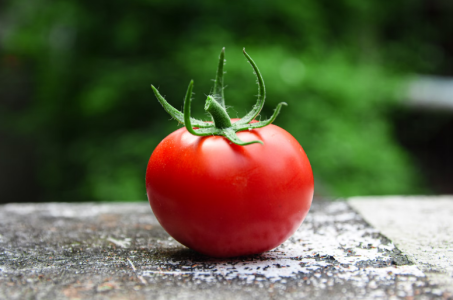Are your tomatoes splitting? Here’s the real reason and what you can do about it
- Replies 0
You step into the garden to pick a ripe, red tomato—only to find an ugly crack slicing through its skin. If that sounds familiar, you’re not alone.
Many home gardeners run into this issue just as their tomatoes hit peak ripeness.
But before you toss those split fruits aside, let’s get into why tomatoes crack, how to prevent it, and whether they’re still safe to eat.
Cracking happens when a tomato plant suddenly takes in too much water after a dry stretch.
The inside of the fruit swells faster than the skin can stretch, causing it to split open.
As Food & Wine puts it, Excess water causes the inside of the fruit to grow much faster than the skin on the outside.
It’s essentially a hydration overload—and the result can be either vertical splits (from the stem downward) or horizontal cracks that circle the fruit.
This issue isn’t limited to ripe tomatoes. Green ones can also split if they’re exposed to sudden changes in moisture.
Whether it’s a rainstorm after a dry week or a gardener’s overcorrection after missing a watering, the outcome is the same. Your watering habits matter just as much as the weather.
Vertical cracks tend to be deeper and can leave the tomato vulnerable to rot, bacteria, or insects.
Horizontal cracks, on the other hand, are often shallow and may even heal over as the fruit continues to ripen.
Recognizing the type of split can help you decide what to do next. In many cases, the tomato is still edible—you just have to inspect it carefully.
The weather may be out of your control, but a few changes in care can make all the difference. The first step is to water consistently.
Tomatoes prefer about an inch of water per week, and it’s best delivered slowly and regularly.
During dry periods, watering every two to three days helps avoid the stress that leads to cracking.
Drip irrigation and soaker hoses are ideal tools—they deliver moisture directly to the roots without flooding the plant.
Adding mulch around the base helps keep soil moisture levels stable by reducing evaporation and shielding roots from temperature swings.
Fertilizer also plays a role. Tomatoes are heavy feeders, but too much nitrogen can cause them to grow too fast, which makes the skin more prone to splitting.
A soil test can help you choose the right balance of nutrients.
One more trick? Pick your tomatoes early. Once they start to blush pink, they’ve reached what’s known as the “breaker stage.”
At this point, they’re full-sized and will continue ripening off the vine. Picking them at this stage can protect them from unexpected rain or intense heat.
In most cases, yes—especially if the crack is shallow and the flesh inside looks healthy. Just slice away the damaged area and use the tomato promptly.
But if the split is deep and extends from the stem, take a closer look. Mold, pests, or signs of rot mean it’s safer to compost than consume.
Don’t let imperfect fruit go to waste. Split tomatoes are ideal for recipes where looks don’t matter but flavor counts.
Whether you’re cooking down a sauce, whipping up salsa, or simmering a soup, these tomatoes still have plenty to offer.
Just be sure to use them quickly—cracked tomatoes won’t last long on the counter. Try them in tomato-based curries, garden salsas, Italian stews, or homemade pizza sauce.
Their rich, concentrated flavor makes them a great base for slow-cooked dishes. A quick trim around the crack is often all that’s needed.
Read next:

Have you found a watering rhythm that keeps your tomatoes intact? Do you have a favorite use for split fruit—or a crack-resistant variety you swear by? Share your tips, questions, or garden victories in the comments. We’re here to help each other grow better tomatoes, one harvest at a time.
Many home gardeners run into this issue just as their tomatoes hit peak ripeness.
But before you toss those split fruits aside, let’s get into why tomatoes crack, how to prevent it, and whether they’re still safe to eat.
Cracking happens when a tomato plant suddenly takes in too much water after a dry stretch.
The inside of the fruit swells faster than the skin can stretch, causing it to split open.
As Food & Wine puts it, Excess water causes the inside of the fruit to grow much faster than the skin on the outside.
It’s essentially a hydration overload—and the result can be either vertical splits (from the stem downward) or horizontal cracks that circle the fruit.
This issue isn’t limited to ripe tomatoes. Green ones can also split if they’re exposed to sudden changes in moisture.
Whether it’s a rainstorm after a dry week or a gardener’s overcorrection after missing a watering, the outcome is the same. Your watering habits matter just as much as the weather.
Vertical cracks tend to be deeper and can leave the tomato vulnerable to rot, bacteria, or insects.
Horizontal cracks, on the other hand, are often shallow and may even heal over as the fruit continues to ripen.
Recognizing the type of split can help you decide what to do next. In many cases, the tomato is still edible—you just have to inspect it carefully.
The weather may be out of your control, but a few changes in care can make all the difference. The first step is to water consistently.
Tomatoes prefer about an inch of water per week, and it’s best delivered slowly and regularly.
During dry periods, watering every two to three days helps avoid the stress that leads to cracking.
Drip irrigation and soaker hoses are ideal tools—they deliver moisture directly to the roots without flooding the plant.
Adding mulch around the base helps keep soil moisture levels stable by reducing evaporation and shielding roots from temperature swings.
Fertilizer also plays a role. Tomatoes are heavy feeders, but too much nitrogen can cause them to grow too fast, which makes the skin more prone to splitting.
A soil test can help you choose the right balance of nutrients.
One more trick? Pick your tomatoes early. Once they start to blush pink, they’ve reached what’s known as the “breaker stage.”
At this point, they’re full-sized and will continue ripening off the vine. Picking them at this stage can protect them from unexpected rain or intense heat.
In most cases, yes—especially if the crack is shallow and the flesh inside looks healthy. Just slice away the damaged area and use the tomato promptly.
But if the split is deep and extends from the stem, take a closer look. Mold, pests, or signs of rot mean it’s safer to compost than consume.
Don’t let imperfect fruit go to waste. Split tomatoes are ideal for recipes where looks don’t matter but flavor counts.
Whether you’re cooking down a sauce, whipping up salsa, or simmering a soup, these tomatoes still have plenty to offer.
Just be sure to use them quickly—cracked tomatoes won’t last long on the counter. Try them in tomato-based curries, garden salsas, Italian stews, or homemade pizza sauce.
Their rich, concentrated flavor makes them a great base for slow-cooked dishes. A quick trim around the crack is often all that’s needed.
Read next:
- Why is everyone freaking out over this "iconic" tomato at a restaurant? The internet can't decide if it's genius or just plain weird!
- Tomato recall linked to salmonella: What you need to know to stay safe
Key Takeaways
- Tomato splitting happens when fruit absorbs water too quickly after dry conditions.
- Consistent watering, mulching, balanced fertilizing, and early picking help reduce cracks.
- Most cracked tomatoes are safe to eat if there’s no mold, rot, or insect damage.
- Split fruit works well in cooked dishes like sauces, stews, and curries.







